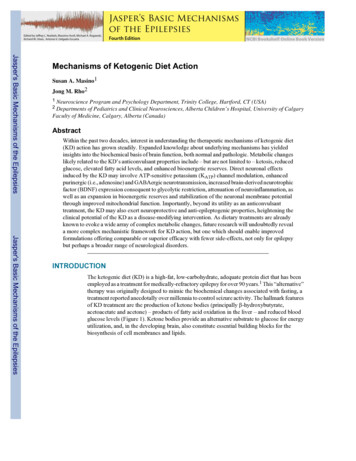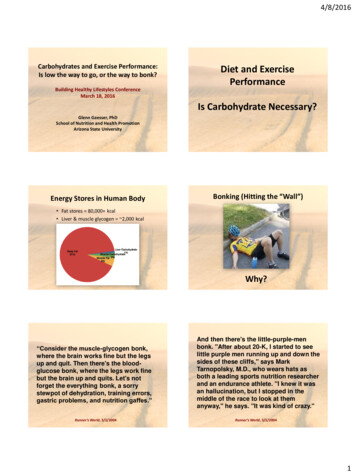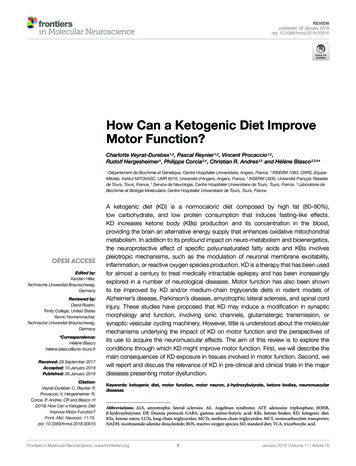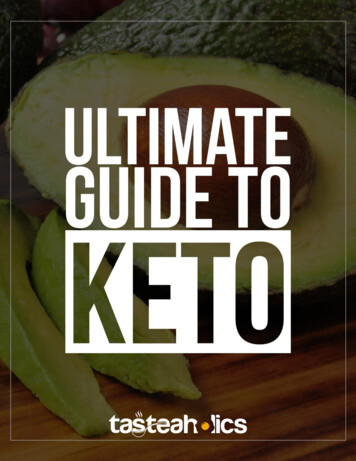
Transcription
Jasper's Basic Mechanisms of the EpilepsiesMechanisms of Ketogenic Diet ActionSusan A. Masino1Jong M. Rho21 Neuroscience Program and Psychology Department, Trinity College, Hartford, CT (USA)2 Departments of Pediatrics and Clinical Neurosciences, Alberta Children’s Hospital, University of CalgaryFaculty of Medicine, Calgary, Alberta (Canada)AbstractJasper's Basic Mechanisms of the EpilepsiesWithin the past two decades, interest in understanding the therapeutic mechanisms of ketogenic diet(KD) action has grown steadily. Expanded knowledge about underlying mechanisms has yieldedinsights into the biochemical basis of brain function, both normal and pathologic. Metabolic changeslikely related to the KD’s anticonvulsant properties include – but are not limited to – ketosis, reducedglucose, elevated fatty acid levels, and enhanced bioenergetic reserves. Direct neuronal effectsinduced by the KD may involve ATP-sensitive potassium (KATP) channel modulation, enhancedpurinergic (i.e., adenosine) and GABAergic neurotransmission, increased brain-derived neurotrophicfactor (BDNF) expression consequent to glycolytic restriction, attenuation of neuroinflammation, aswell as an expansion in bioenergetic reserves and stabilization of the neuronal membrane potentialthrough improved mitochondrial function. Importantly, beyond its utility as an anticonvulsanttreatment, the KD may also exert neuroprotective and anti-epileptogenic properties, heightening theclinical potential of the KD as a disease-modifying intervention. As dietary treatments are alreadyknown to evoke a wide array of complex metabolic changes, future research will undoubtedly reveala more complex mechanistic framework for KD action, but one which should enable improvedformulations offering comparable or superior efficacy with fewer side-effects, not only for epilepsybut perhaps a broader range of neurological disorders.INTRODUCTIONThe ketogenic diet (KD) is a high-fat, low-carbohydrate, adequate protein diet that has beenemployed as a treatment for medically-refractory epilepsy for over 90 years.1 This “alternative”therapy was originally designed to mimic the biochemical changes associated with fasting, atreatment reported anecdotally over millennia to control seizure activity. The hallmark featuresof KD treatment are the production of ketone bodies (principally β-hydroxybutyrate,acetoacetate and acetone) – products of fatty acid oxidation in the liver – and reduced bloodglucose levels (Figure 1). Ketone bodies provide an alternative substrate to glucose for energyutilization, and, in the developing brain, also constitute essential building blocks for thebiosynthesis of cell membranes and lipids.
Page 2Jasper's Basic Mechanisms of the EpilepsiesFigure 1. Metabolic pathways involved in ketogenic diet (KD) treatmentJasper's Basic Mechanisms of the EpilepsiesIn the liver, fatty acids are ordinarily converted into acetyl-CoA which enters the tricarboxylic acid (TCA) cycle. When fatty acidlevels are elevated and exceed the metabolic capacity of the TCA cycle, acetyl-CoA is shunted to ketogenesis. Two acetyl-CoAscan combine through a thiolase enzyme to produce acetoacetyl-CoA, which is a precursor for the synthesis of acetoacetate (ACA)and β-hydroxybutyrate (BHB). Acetone, the other major ketone body, is produced primarily from spontaneous decarboxylationof ACA, and can be eliminated as a volatile substrate through the lungs and kidneys. In the blood, ACA and BHB are transportedfrom the vascular lumen to the brain interstitial space, and to both glia and neurons, by monocarboxylic acid transporters (MCTs).MCT-1 is the principal carrier localized to the vascular endothelium. Within neurons, both ACA and BHB are transported directlyinto mitochondria, and then converted to acetyl-CoA through several enzymatic steps. BHB is converted to ACA through D-βhydroxybutyrate dehydrogenase, and ACA undergoes subsequent conversion to acetoacetyl-CoA through a succinyl-CoAtransferase enzyme. Finally, acetoacetyl-CoA-thiolase converts acetoacetyl-CoA to two acetyl-CoA moieties which then enterthe TCA cycle. Abbreviations: CAT (carnitine-acylcarnitine translocase), FAO (fatty acid oxidation), ACA (acetoacetate), BHB(β-hydroxybutyrate), MCT-1 (monocarboxylate transporter-1), GLUT-1 (glucose transporter-1), BBB (blood-brain barrier),CPT-1 (carnitine palmitoyl transferase), UCP (uncoupling protein), ATP (adenosine triphosphate), ❶(3-hydroxybutyratedehydrogenase), ❷ (succinyl-CoA3-oxoacid CoA transferase), ❸ (mitochondrial acetoacetyl-CoA thiolase). MRC,mitochondrial respiratory complex. Reprinted with permission from Kim dY, Rho JM, The ketogenic diet and epilepsy. Curr OpinClin Nutr Metab Care 2008; 11:113–20.Throughout much of the past century, the popularity of the KD has waxed and waned. Initialenthusiasm was fueled by dramatic success rates, reported entirely in uncontrolled studies, butwas quickly supplanted by new antiepileptic drugs (such as phenytoin) that became availablein the 1930’s. Clinicians found it more convenient to administer a drug than supervise a regimenrequiring scrupulous attention to foodstuffs and avoidance of anti-ketogenic carbohydrates.Notwithstanding the prolonged stigma of being a fad therapy and one without a crediblescientific basis, the KD experienced a major resurgence in the late 1990’s, mostly as aconsequence of serendipitous media attention and the continued failure of even newerantiepileptic drugs to offer significantly enhanced clinical efficacy.Today, the KD is acknowledged as a proven therapy for epilepsy.2 The growing number ofclinical KD treatment centers throughout the world serves as a testament to the notion thatirrespective of cultural and ethnic differences that define dietary and nutritional practices, afundamental shift from carbohydrate-based consumption to fatty acid oxidation results insimilar clinical effects. Despite such broad use, surprisingly little is understood about itsunderlying mechanisms of action. This may be due to the inherently complex interplay betweenthe network dynamics of the human brain (particularly in the disease state and duringMechanisms of Ketogenic Diet Action
Page 3Jasper's Basic Mechanisms of the Epilepsiesdevelopment), and the myriad biochemical and physiological changes evoked by consumptionof dietary substrates. It has not been straightforward to determine cause-and-effectrelationships in this bewildering context, and one cannot be certain whether specific molecularand cellular alterations observed are relevant or simply represent epiphenomena. Thisknowledge gap has hindered efforts to develop improved or simplified treatments (such as a“KD in a pill”3) that obviate the strict adherence to protocol that the KD requires. However,research efforts have been intensifying over the past decade, and recent investigations haveprovided new insights and molecular targets.Herein we outline the most prominent mechanisms underlying KD action. We introduce thesemechanisms chronologically as they were proposed, integrate these ideas with more recentfindings, and examine the evidence for the broad neuroprotective properties of the KD – thelatter, if validated, would highlight the clinical potential of the KD as a broadly encompassingdisease-modifying intervention.4–7 Whether the cellular mechanisms responsible for theclinical utility of the KD for human epilepsies are identical to those observed in animal models,or whether they overlap with the mechanisms that afford clinical benefits for other neurologicalconditions, remains to be determined. An integration of older and newer ideas regardingunderlying mechanisms of KDs might represent the ideal scientific strategy to eventuallyunlock the secrets of this metabolism-based therapy.HISTORICAL AND CLINICAL PERSPECTIVESEarly Hypotheses of KD ActionJasper's Basic Mechanisms of the EpilepsiesInitial studies into the mechanisms underlying KD action focused on concepts of acidosis,dehydration and increased ketone concentrations – largely because these were the readilyapparent ideas stemming from clinical implementation and observations.8 Mild dehydrationwas postulated as necessary, possibly to maximize concentrations of ketones which werebelieved to render anticonvulsant effects. As discussed later, however, peripheral ketoneconcentrations alone (whether measured in urine or blood) are not tightly correlated withseizure control, and there is no evidence that dehydration or fluid restriction is necessary forclinical efficacy.9 Nonetheless, because ketone metabolism generates protons and pH-loweringmetabolic products, decreased pH (i.e., acidosis) was also considered initially to be a key aspectof the KD. However, there is no clear evidence that a KD significantly lowers brain pH, letalone that a decrease in pH – however small – may be associated with its anticonvulsantactivity.10Despite these negative results, however, it is possible that the KD may induce dynamic anddifferential pH changes in local microdomains; this possibility has yet to be assayed duringKD treatment. Indeed, local compartments have been shown to exhibit differential pHregulation during neuronal activity,11,12 and recent work has highlighted novel pH-relatedanticonvulsant mechanisms. For example, acidosis in vivo reduced seizure activity viaactivation of a depolarizing acid-sensing ion channel 1a (ASIC1a) localized to hippocampalinterneurons.13 Other studies showed that decreased intracellular pH during periods ofincreased neuronal excitability releases adenosine and decreases excitatory synaptictransmission and bursting in in vitro hippocampal slices.14 Thus, pH-related mechanisms mayoffer new prospects for anticonvulsant therapies, and techniques enabling higher resolutionstudies of pH dynamics in vivo and within neuron-glia microdomains may resolve permanentlywhether the KD acts in part by changing pH - which can influence proton-sensitive ion channelssuch as N-methyl-D-aspartate (NMDA) receptors15,16 and specific GABAA receptorisoforms.17–19Mechanisms of Ketogenic Diet Action
Page 4Clinical InsightsJasper's Basic Mechanisms of the EpilepsiesFrom decades of clinical experience, it is been observed that almost any diet resulting inketonemia and/or reduced blood glucose levels can produce an anticonvulsant effect.Comparable clinical efficacy has been seen using KDs comprised of either long-chaintriglycerides (LCTs)20,21 or medium-chain triglycerides (MCTs).22–25 Within the last decade,two additional variations of these KDs have emerged26: the modified Atkin’s diet (MAD)27–30 and the low-glycemic index treatment (LGIT).31–33 The former allows for more liberalcarbohydrate consumption and does not significantly restrict protein intake compared to theclassic KD, whereas the latter was developed to mirror reduced glucose levels during KDtreatment, and as such is based on a fundamental adherence to foods with low glycemic indices.The glycemic index is a value that describes the extent to which a carbohydrate is absorbedand elevates blood glucose, and lower indices correlate with slower insulin responses comparedto glucose. Interestingly, LGIT does not induce the prominent ketosis seen with classic KDsand the Atkin’s diet.Thus, at present, there are three primary dietary therapies for epilepsy: the traditional KD (avariation of which is the MCT diet), the MAD, and the LGIT. All three diets have beenincreasingly studied and are being used currently for both children and adults in centersworldwide. Importantly, available evidence indicates that dietary composition per se does notappear to affect the anticonvulsant efficacy of the diet, as long as there is a degree of sustainedketosis and/or calorie restriction.34–39 And, although there are patients with epilepsy whorespond dramatically within days of initiating the KD, maximum efficacy is not generallyachieved for several days or weeks after initiation, suggesting that longer-term adaptivemetabolic and/or genetic mechanisms may be recruited.40 These adaptations are likelygeneralized throughout the epileptic brain, irrespective of underlying pathology or geneticpredisposition to seizures, because the KD is an effective treatment for diverse epilepticconditions.41,42 Table 1 provides a general context for the subsequent discussion, comparingand contrasting key parameters observed clinically and in experimental models.Jasper's Basic Mechanisms of the EpilepsiesTABLE 1Ketogenic Diet: Clinical Correlates and Experimental ObservationsClinical CorrelateObservation in Animal ModelsSeizure typeKD is effective against manyseizure types and epilepsysyndromesKD is effective in models employing a widevariety of seizure paradigmsAge rangeChildren extract and utilizeketones from blood moreefficiently than older individualsYounger animals respond better to the KDCalorie restrictionAssociated with seizurereductionIncreases seizure thresholdDiet typeClassic and MCT KDs areequally efficaciousClassic and MCT diets both increase seizurethresholdKetosisKetosis is necessary but notsufficient for seizure controlA threshold level of ketosis is necessary but notsufficient to explain anti-seizure effectsFatPractical concerns limit theketogenic ratio; possible role offat chain length and degree ofsaturation (e.g., PUFAs)Improved efficacy with higher ketogenicratios; uncertain if type of fat is a criticalvariableLatency to KD effectivenessSeizures may be seen during thepre-diet fast or after a latency ofdays to weeksSeveral daysMechanisms of Ketogenic Diet Action
Page 5Jasper's Basic Mechanisms of the EpilepsiesReversal of protective effect whenKD discontinuedClinical CorrelateObservation in Animal ModelsRapid (hours)Rapid (hours)Abbreviations: KD, ketogenic diet; MCT, medium chain triglycerides; PUFAs, polyunsaturated fatty acids. Adapted withpermission from reference 59.ANIMAL MODELSAcute ModelsThe bulk of the existing experimental literature pertaining to the KD involves studies in whichvarious high-fat treatments are implemented prior to acute provocation with either electricalor chemoconvulsant stimulation in rodents. In these studies, animal diets have modeled theclassic LCT diet and conform closely to either a 4:1 or approximately 6:1 ketogenic ratio offats to carbohydrates plus protein (by weight). In general, irrespective of precise dietaryformulation – as long as ketosis is seen, reflecting a shift from primarily glycolysis tointermediary metabolism – anticonvulsant effects have been observed. Indeed, whetherseizures are provoked by corneal electroshock, hydration electroshock, maximal electroshock,pentylenetetrazol (PTZ), bicuculline, semicarbazide, kainate, fluorothyl, or 6 Hz stimulation,chronic pre-treatment with a KD appears to render anticonvulsant effects.43–53 It should benoted that the KD is not anticonvulsant in all acute animal models, particularly in mice,54–56and its effects may be of limited duration44 or can even exacerbate (maximal)seizures.37,46,47,57,58 But while such results may raise concerns for the validity of the studiesas a whole, one must recall that the KD is not universally effective in patients with medicallyrefractory epilepsy.20,21,41Jasper's Basic Mechanisms of the EpilepsiesFurther complicating interpretation of the animal literature, the highly variable methodologiesused (e.g., use of calorie restriction, age at initiation and duration of therapy, dietary ratios andformulations, timing of treatment, mode of seizure induction, etc.) have made crosscomparisons nearly impossible.59,60 Regarding observations in rodent models, anticonvulsantefficacy of 4:1 or 6:1 KDs may be confounded by the fact that they did not control for intakeof vitamins, minerals and antioxidants. Highlighting this cautionary note, when a balanced KDwas utilized in the PTZ, kainate or fluorothyl models, anticonvulsant efficacy was not actuallyobserved.55 Thus, acute animal studies highlight a number of problems with these experimentalapproaches and have challenged our ability to directly translate animal research to the humanepileptic condition.Chronic Animal ModelsPublished animal studies, in attempting to replicate the clinical experience, suggest that dietaryeffects in controlling brain excitability extend beyond species boundaries, but they have donelittle to enhance our knowledge of underlying mechanisms of action. Rather, they raise moreissues and highlight the necessity of investigating KD effects in a more clinically relevantmodel – namely, a chronic model characterized by early-onset, medically-refractory epilepsythat is responsive to a clinically validated formulation of the KD.61 That said, it is also importantto recognize that species differences, particularly with regard to fatty acid metabolism andblood-brain-barrier properties, may dictate incongruency of experimental results.Muller-Schwarze and colleagues62 provided the first evidence that a KD can retardepileptogenesis in a chronic animal model. In this study, rats were first subjected to kainateinduced status epilepticus, and then treated with a KD. Seizure frequency and duration,recorded after the latent period, were both significantly lower in the KD-treated groupMechanisms of Ketogenic Diet Action
Page 6Jasper's Basic Mechanisms of the Epilepsiescompared to controls. Further, there was a significant reduction in the extent of mossy fibersprouting in the KD-fed group. In another model of chronic epilepsy, the KD was shown toprolong lifespan in succinic semialdehyde dehydrogenase (SSADH)-deficient (Aldh5a1 / )mice which are characterized by GABA deficiency, recurrent seizures and early demise.63Interestingly, KD treatment restored spontaneous inhibitory synaptic currents to control levels,effects that were later attributed to an increase in the number of mitochondria in hippocampus,as well as a restoration of reduced hippocampal ATP levels compared to controls.64Comparable to induced models, the KD has also been shown to be effective in geneticallydetermined epilepsy models. The EL mouse is a seizure-susceptible inbred strain believed torepresent a model of multifactorial idiopathic partial epilepsy with secondarygeneralization.65 Environmental stimulation such as repetitive handling can induce seizures inEL mice and facilitate epileptogenesis beginning at P30. Generalized seizures generallymanifest by the second postnatal month and persist throughout later life.66 When fed a 4.75:1KD formula over a 10-week period, seizure susceptibility scores were significantly reducedcompared to controls after 3 weeks, but this difference disappeared by week 7.67 These transientresults were similar to what had been reported earlier in the kindling model.44More recently, effects of a 6.3:1 KD were investigated in Kcna1-null mice lacking the geneencoding the delayed rectifier potassium channel α subunit, Kv1.1. The frequency ofspontaneous recurrent seizures was significantly reduced in KD-fed mice compared to wildtypes68 This observation is of particular interest due to the facts that: (1) Kcna1-null miceexhibit progressive histological changes in the hippocampus similar to that observed in humanepileptic tissues and in many animal models of temporal lobe epilepsy;69 and (2) the Kcna1gene is one of only few epilepsy genes in a developmental animal model that has a homologuein a human epileptic condition.70,71MECHANISTIC STUDIES IN THE EARLY RENAISSANCE ERAJasper's Basic Mechanisms of the EpilepsiesUltimately, to produce anticonvulsant effects, the KD must reduce neuronal excitability and/or synchony. The essential currency of neuronal excitability – both normal and aberrant – isthe complex array of primarily voltage-gated and ligand-gated ion channels that determine thefiring properties of neurons and mediate synaptic transmission. At present, there appears to beat least six important mechanisms through which the currently available antiepileptic drugsexert their anticonvulsant action,72–74 and the vast majority of molecular targets are ionchannels and transporters localized to plasmalemmal membranes. In this light, a fundamentalquestion pertaining to KD effects at the cellular and molecular levels has been whether any ofthe metabolic substrates (e.g., ketone bodies) elaborated by this “non-pharmacological”intervention can interact with ion channels known to regulate neuronal excitability. Broadlyspeaking, this does not appear to be the case. Given this tantalizing situation, there has beenintense recent interest in how metabolic changes induced by a KD translate in a causal mannerto a reduction in neuronal excitability and/or synchrony. Most of the postulated mechanismsdiscussed below are considered in the context of multiple lines of evidence, from human dataas well as in vivo and in vitro model systems.Ketone BodiesPerhaps the most obvious and potentially important clinical observation pertaining to themechanistic underpinnings of the KD is the prominent ketonemia seen in patients. At facevalue, it would seem to be a relatively straightforward matter to establish a cause-and-effectrelationship between the degree of ketonemia and seizure control. Further, it should be nosurprise that since the 1930’s, researchers have asked time and again whether ketone bodiesmight themselves exert anticonvulsant effects.49,75–78 Despite intense scrutiny, this matterremains unresolved. It is well known that seizure control gradually improves within the firstMechanisms of Ketogenic Diet Action
Page 7Jasper's Basic Mechanisms of the Epilepsiesfew weeks of initiating the KD, as serum ketone levels steadily increase. Interestingly, seizurecontrol can be lost abruptly when ketosis is broken, usually through ingestion ofcarbohydrates,22 again implicating ketone body action. Further, blood β-hydroxybutyrate(BHB) levels can appear to correlate directly with seizure control in children placed on aKD,20,21,79 but the relationship is inconsistent.41 The threshold BHB level for seizure controlappears to be a blood concentration of 4 mmol/L for children successfully maintained on theKD for 3 or 6 months,79 and investigators have used such clinical observations to model KDconditions in both animal models and in vitro studies. In general, blood levels are bettercorrelated with seizure control than urinary levels; the latter are obtained through dipstickassessments that grossly reflect only acetoacetate levels.79,80Keith first reported that acetoacetate (ACA) protected against thujone-induced seizures inrabbits,75 an observation that was later confirmed in an audiogenic seizure susceptible mousemodel.49 Later, Likhodii and colleagues provided direct evidence that acetone could blockinduced seizures in multiple animal models of seizures and epileptogenesis.76 Theydemonstrated that acetone, when injected intraperitoneally, yielded plasma and cerebrospinalfluid (CSF) concentrations consistent with doses used to suppress seizures. In support of this,clinical investigators found that acetone was detectable in the brains of fully controlled KDtreated epileptic patients using proton magnetic resonance spectroscopy, and was estimated tobe present in concentrations of approximately 0.7 mM.81 Curiously, while in vivo experimentshave demonstrated the acute anticonvulsant properties of ACA and acetone, there are as yetno convincing data indicating that the major ketone body, BHB, can exert similar effects.Intriguingly, however, recent work suggests that metabolizing BHB rather than glucose reducesthe availability of glutamate, which could then contribute to anticonvulsant and potentiallyneuroprotective effects.82Jasper's Basic Mechanisms of the EpilepsiesCondering the other ketone bodies, the link between ACA and acetone is particularly tight;ACA is spontaneously decarboxylated to acetone, and as such, it was speculated that ACA’sacute anticonvulsant effects might be due to immediate conversion to acetone and subsequentlyto its many downstream derivatives.83 But more recent work has clearly demonstrated that theanticonvulsant activity of acetone is not dependent upon its metabolites,84 so the exactmechanism of acetone’s rather broad-spectrum anticonvulsant activity remains unknown. Ithas been proposed that S-D-lactoylglutathione, an intermediate of acetone metabolism, mightactivate voltage-gated potassium channels and thereby hyperpolarize the neuronal cellmembrane,85 but there is as yet no direct evidence. And there is yet another report that acetoneand BHB enhanced inhibitory glycine receptors, whereas BHB alone was able to enhanceGABAA-receptor mediated currents – but all of these actions were observed at highlysupratherapeutic (i.e., anesthetic) concentrations, not seen during KD treatment.86Investigations involving potential anticonvulsant compounds would not be complete withoutthe use of cellular electrophysiological techniques, and thus it was of interest whether ketonebodies would affect any of the principal ion channels that are the primary targets of clinicallyused antiepileptic drugs. Surprisingly, such studies were initiated little more than a decade ago.Thio and colleagues87 reported that acute application of low millimolar concentrations of BHBor ACA did not affect synaptic transmission in normal rat hippocampus, and did not affectGABAA receptors, ionotropic glutamate receptors, or voltage-gated sodium channels over awide concentration range (300 μM – 10 mM). The fact that ACA was ineffective in their handswas indeed surprising, especially given its clear anticonvulsant effects when administered invivo.49,76Recently, however, Ma and colleagues77 found that BHB and ACA – at physiologicalconcentrations – reduced the spontaneous firing of GABAergic neurons in rat substantia nigrapars reticulata (SNr; a subcortical structure that influences seizure propagation) by openingMechanisms of Ketogenic Diet Action
Page 8Jasper's Basic Mechanisms of the Epilepsiescellular membrane-bound ATP-sensitive potassium (KATP) channels. KATP channels, a typeof inwardly rectifying potassium channel (Kir6) that is activated when intracellular ATP levelsfall, were long considered logical candidates for linking metabolic changes to cellularmembrane excitability.88 Despite the intuitive appeal of this observation, an inherentdiscrepancy remains to be reconciled. Consistently, studies have shown that the KD canincrease levels of ATP and other bioenergetic substrates through enhanced mitochondrialrespiration.89–93 Because high ATP levels block KATP channel activity, it is unclear howopening of these channels is achieved by infusion of ketone bodies in the SNr.Yet another intriguing link between ketone bodies and neuronal excitability was recentlyreported. Juge and colleagues demonstrated that ACA inhibits vesicular glutamate transporters(VGLUTs), which are required for exocytotic release of the excitatory neurotransmitterglutamate, specifically by competing with an anion-dependent regulatory site on presynapticvesicles.78 These investigators demonstrated that ACA decreased the quantal size of excitatoryneurotransmission at hippocampal synapses, and suppressed glutamate release and seizuresevoked by the convulsant 4-aminopyridine in rats. This novel finding may be a plausibleexplanation for the acute in vivo effects of ACA observed nearly eight decades earlier,75 butACA is reported to have other actions as well, notably on mitochondria.92,94 The other caveatis that ACA is highly unstable, and undergoes spontaneous decarboxylation to acetone whichmay have other actions. Further, in the presence of BHB dehydrogenase, ACA is interconvertedto the major ketone body BHB. Thus, it appears that seemingly straightforward metabolicsubstrates are players in a more complex arena.Jasper's Basic Mechanisms of the EpilepsiesIn summary, the available evidence thus far fails to strongly support a primary mechanisticrole for ketone bodies in the clinical efficacy of the KD, as no compelling molecular target hasbeen identified and linked to attenuation of spontaneous seizures in a chronic epilepsy model.At this juncture, it is unlikely that there is only one relevant action of any of the primary ketonebodies on neuronal activity. If ketones are indeed fundamentally required for the anticonvulsantefficacy of the KD, they are more likely contributory to other parallel (and possibly synergistic)effects of the diet. Of the various hypotheses proposed, the most likely candidate mechanismsare membrane hyperpolarization through activation of potassium channels, increasedGABAergic neurotransmission, or a reduction in vesicular glutamate release. Ketones havebeen shown to reduce brain glucose consumption,95 and reduced glucose is another keyhallmark of a KD discussed in more detail below.Age-dependence of Ketone UtilizationMultiple studies and anecdotal observations have suggested that the KD is most effective inimmature animals or infants and children,34,45,54,58,96 and is perhaps due to greater fatty acidoxidation of breast milk which is high in fats, more efficient extraction of ketone bodies fromthe blood, and an early age-dependent surge in the expression of the monocarboxylic acidtransporters, MCT1 and MCT2.97,98 If indeed the degree of ketonemia is a major determinantof seizure control, one would predict that younger patients would respond better than olderones. Clinical studies to date would tend to support this notion, although it is becoming clearerthat adolescents and adult patients with epilepsy also benefit from KD treatment.99,100 Incontrast, there is abundant laboratory evidence suggesting that the anticonvulsant effects ofKDs are not age-dependent.40There is recent controversy involving ketone bodies aimed straight at the heart of a scientificdogma – that is, the notion that γ-aminobutyric acid (GABA)-mediated responses in the earlydeveloping brain are excitatory, not inhibitory.101,102 Zilberter and colleagues reported thatthe addition of ketones and other metabolic substrates
Mechanisms of Ketogenic Diet Action Susan A. Masino1 Jong M. Rho2 1 Neuroscience Program and Psychology Department, Trinity College, Hartford, CT (USA) 2 Departments of Pediatrics and Clinical Neurosciences, Alberta Children’s Hospital, University of Calgary Faculty of Medicine, Calgary, Alberta (Canada) Abstract Wit










